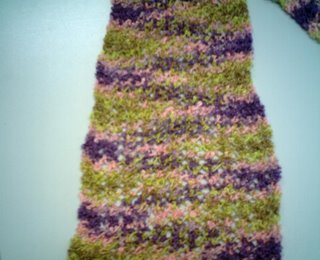Fiz um cachecol simples na última semana de Março, e este é para mim (depois de ter feito um para a minha mãe, um para o meu irmão e um para uma troca com a Noo). Usando o bouclé de seda e mohair que ganhei num concurso (e que já não se fabrica, para minha pena, porque é deliciosamente leve e macio), fiz isto:
I have knit a simple scarf for me in the last week of March, and this one is for me (after having knit one for my mother, one for my brother and one to trade with Noo. I used the silk mohair boucle I won in a contest (which was discontinued, to my chagrin, because it is wonderfully light and soft) to knit this:



Padrão: inventado, com base numa sugestão de alguém num encontro de tricotadeiras. Usando uma agulha bem maior que a recomendável para o fio (usei as de 8 mm, e a recomendada era 5.5 mm), montei 25 pontos (o que importa é ser número ímpar. Depois, é fazer P1, *YO, P2tog*, e repetir o entre asteriscos até ao fim da carreira. Virar as agulhas e fazer exactamente o mesmo na volta seguinte. E assim até acabar o fio. [desculpem, mas digo em inglês, porque em português parece que há várias terminologias. Em português, eu diria que faço sempre o primeiro ponto da volta em revezil, depois vou fazendo uma laça e dois juntos em revezil até ao fim. Mas como há quem chame liga ao que eu chamo revezil, e há quem chame revezil ao que eu chamo canelado, fico-me pelo inglês que pelo menos é unívoco].
Notas sobre o padrão: Tinha pouco fio. Por isso, fui fazendo amostras com diversas agulhas e diversos pontos, usando 10 metros de fio, para ver que dimensão teria o cachecol final em cada caso. Ao fazer as amostras, apercebi-me que com certas combinações de agulha, ponto e número de malhas montadas obtinha aquele efeito em ziguezague. Com pequenas variações perdia-se o ziguezague e as cores misturavam-se de forma desinteressante. Por isso, foi só procurar uma combinação que funcionasse, usando a Matemática e a intuição. A Matemática é nossa amiga, fixem isso que é importante!
Ficou macio, leve e arejado (claro). Tem bom cair e um tamanho que me agrada.
Pattern: I invented it, from a suggestion someone gave me on a knitters meeting. Using a much bigger needle size than the recommended to this yarn (I used 8 mm, when the recommended was 5.5 mm), I cast on 25 stitches (what matters is that you cast on an odd number of stitches). Then, P1, *YO, P2tog*, and repeat the part between stars, until the end of the row. Turn needles and knit exactly the same until the end of the row. And so on until the yarn is almost all used. Cast off.
Notes about pattern: I did not have much yarn. So, I knitted several swatches in several stitches and using several needle sizes, using 10 meters of this yarn, to calculate what size would have the final scarf in each case. When knitting the swatches, I saw that some combinations of needle, stitch and number of cast-on stitches gave this interesting zig-zag pooling effect. A small variation would make the zig-zag disappear, and the colours would mix in an uninteresting way. So, I just had to search a combination that would work, using both Mathematics and intuition. Mathematics is our friend, believe me, this is important!
The scarf is soft, light and airy (of course). It has a good drape and I like its size.

5 comentários:
Ficou muito giro! Gostei imenso das variações de cores que faz.
Bjs
Mónica
Ficou bem bonito, o trabalho extra compensou! ;o)
jinhos
It looks lovely! Very light, but snuggily at the same time?
What beautiful colors-Happy Birthday to your bog!
Your scarf is beautiful!
Thanks for the kind words that you left on my blog.
Enviar um comentário